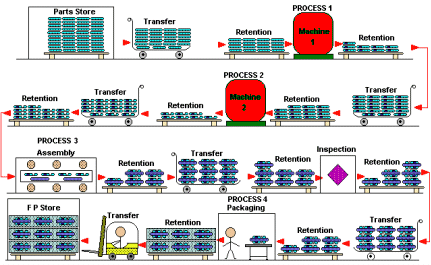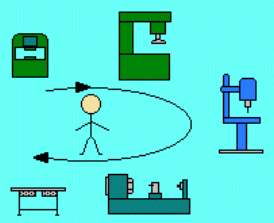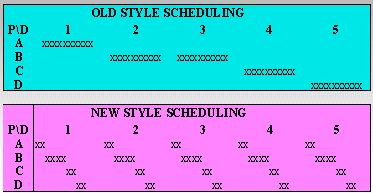|
navigation
consulting
services
training
services
specials
reading
material
resources
|
Traditional batch manufacturing presents a number of drawbacks:

- Lead times are long
- Many non-value adding activities
- High WIP/in-process stock
- Generally requires Quality Control
- Expensive equipment, long to set-up, difficult to maintain
- Generally poor productivity (output per person)
- Space, methods and logistics waste
- De-motivated/frustrated single-skill personnel
- and others
All the above drawbacks are eliminated/reduced by flow manufacturing, and other benefits are introduced:

- Lead time is drastically reduced
- Non-value adding activities are eliminated/minimised
- WIP/in-process stock is minimised
- Often can do without (external) Quality Control
- Equipment is inexpensive, fast/easy to set-up and maintain
- Highest productivity
- Minimal or no waste
- Motivated, involved, satisfied multi-skill personnel
- The system is "responsive", flexible, dynamic
- Capable of producing and delivering fast small lots as today's monster clients want
- and others
Flow Production, the heart of Lean Manufacturing, is based on a number of rules and presents a number of corresponding features:
- Machines, processing stations, workplaces are positioned in processing sequence, with minimal "white space" in between
- Equipment is specialised, dedicated
- Flow is based, wherever possible, on a one-piece or smallest batch criterion
- Operations are pull, performed in a vertical, flow-shop layout
- Operations are multi-process, performed by multi-skill operators
- The overall manufacturing process is synchronised with market demand, and based on the so-called takt time.

Golden Rule: "...produce daily what you sell daily..."
- When the Manufacturing Cycle-Time is based on the takt-time production scheduling changes and becomes much simpler:

micro-mix = macro-mix
- Equipment capacity/speed is based also on takt-time - any large excess would only generate WIP and waste.
- Flow Production is based on the zero-defects principle: processes do not create defects to begin with.
Quality Inspection is built-into the productive process: 100% inspection. Poka-Yoke devices are built-into the productive process for guaranteed quality. If defects occur, the process is stopped, and the cause/s found and eliminated forever. There is no double check/double inspection. Inspection Department IS
the Production Department.
- In a FP environment machines/lines must be fast to set-up and change-over. The Achieving Quick Change-Over discipline (more ») is strongly associated with Flow Production (see below)
- In a FP environment machines have a very high OEE - Overall Equipment Effectiveness. The Total Productive Maintenance discipline (more ») is strongly associated with Flow Production.
- In labour-intensive and in machine/labour-intensive situations, best flow-layout arrangements are obtained through the implementation of healthy Cell Manufacturing principles (more »)
- In machine-intensive situations (heavily mechanised/automated production lines), Flow Production is assured by:
- the choice of the right equipment (ideally based on the one-piece flow principle): it must generate minimal labour/logistics waste "around it", or none at all
- healthy implementation of the Total Productive Maintenance discipline
- In "traditional" factories, Flow Production is best introduced starting from the "bottom" (the final packaging/despatching areas), working gradually backwards (upstream).
In many situations the new pull style will hit a solid wall (generally, a large-capacity machine/line). This may become a hinge point between the upstream push style, and the downstream pull system. The net result is a compromise, a hybrid Lean Manufacturing situation.
- Flow Production is strongly allied with TEI - Total Employee Involvement (more »).
In lean factories, workers are highly involved in process improvement (primarily quality and productivity improvement actions), as well as in workplace improvement and management.
Undergoing a Lean Manufacturing and a simultaneous Total Employee Involvement program in a "traditional" factory is feasible and recommended. The one contributes well to the other. The two may well live together, if the necessary preparation work has been done (see under Total Employee Involvement).
Lean Manufacturing allied disciplines: read more » about Cell Manufacturing, Continuous Flow Manufacturing and Achieving Quick Change-Over.
|


